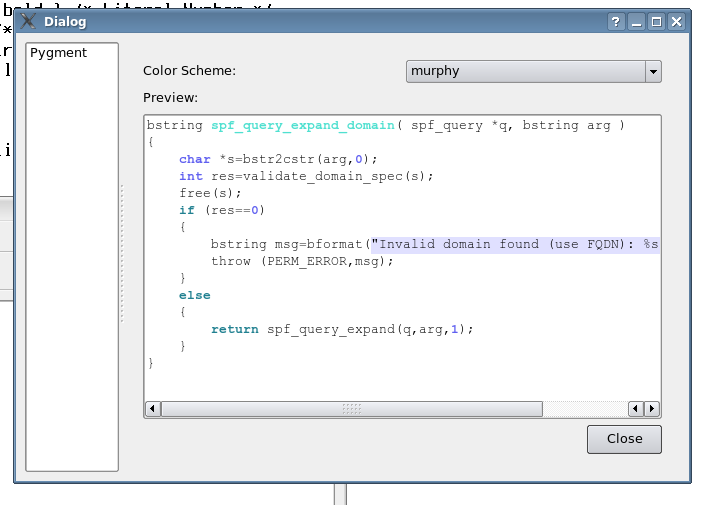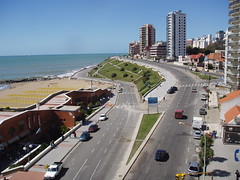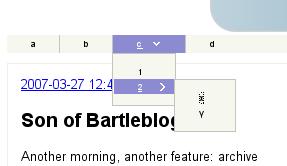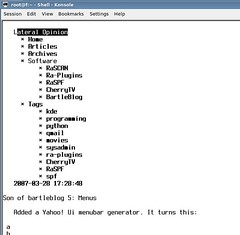Using TinyURL in python
Isn't this neat?
import urllib
def makeTiny(url):
url='http://tinyurl.com/api-create.php?'+urllib.urlencode({'url':url})
return urllib.urlopen(url).read()
>>> makeTiny('http://www.kde.org')
'http://tinyurl.com/3cnthx'Isn't this neat?
import urllib
def makeTiny(url):
url='http://tinyurl.com/api-create.php?'+urllib.urlencode({'url':url})
return urllib.urlopen(url).read()
>>> makeTiny('http://www.kde.org')
'http://tinyurl.com/3cnthx'I had a few minutes waiting for yum to do its thing and added a couple of easy features:

The SilverCity-based code-block syntax highlighting directive was replaced with a version using Pygment which supports more languages and is (I think) nicer looking... and comes with several styles, as you can see above in the configuration dialog.
Other than that, I added support in the backend to:
Regenerate HTML from RST everywhere
Do the same only on items marked "dirty"
A model thingie that shows if there are posts or stories with RST errors
Some GUI love
I need to make the config dialog support more than one gadget at the same time, though ;-)
A lot of new features going on, like openomy based file uploading and links that work like simple rst directives:
.. openomy:: my-file.ext
And you should get a link to the file, stored in the 1GB the openomy guys kindly provide.
Also, you can actually see how the test site looks at //ralsina.me/weblog (using the exact same data as this one).
I actually upload almost every change I do, so it breaks often ;-)
I added a Restructured Text directive that takes as argument the title of one of your (my) flickr pictures, like this:
.. flickr:: pa120071
And produces this:

Which is much nicer than my images have looked for a while.
It can still be improved, probably add a caption, link to image comments if available, etc.
The bad side is that if you don't have internet access the rendering fails.
Added a Yahoo! Ui menubar generator. It turns this:
a b c 1 2 x y d
Into this:

Or this if you are using links:

Or rather into this, which explains why it's necessary (consider this is a very simple menu!):
<script type="text/javascript">
YAHOO.example.onMenuBarReady = function(p_oEvent)
{
// Instantiate and render the menu bar
var oMenuBar = new YAHOO.widget.MenuBar("None",
{ autosubmenudisplay:true,
hidedelay:750,
lazyload:true
});
oMenuBar.render();
}
// Initialize and render the menu bar when it is available in the DOM
YAHOO.util.Event.onContentReady("None", YAHOO.example.onMenuBarReady);
</script>
<div id="None" class="yuimenubar">
<div class="bd">
<ul class="first-of-type">
<li class="yuimenubaritem first-of-type">a </li>
<li class="yuimenubaritem">b</li>
<li class="yuimenubaritem"> c
<div id="c" class="yuimenu">
<div class="bd">
<ul>
<li class="yuimenuitem"> 1</li>
<li class="yuimenuitem"> 2
<div id=" 2" class="yuimenu">
<div class="bd">
<ul class="first-of-type">
<li class="yuimenuitem"> x</li>
<li class="yuimenuitem"> y</li>
</ul>
</div>
</div>
</li>
</ul>
</div>
</div>
</li>
<li class="yuimenubaritem">d</li>
</ul>
</div>
</div>Still some missing features, but a neat thingie already.